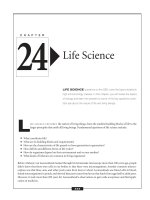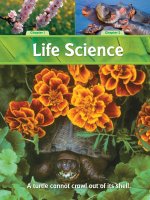2 1 plants (life science)
Bạn đang xem bản rút gọn của tài liệu. Xem và tải ngay bản đầy đủ của tài liệu tại đây (3.02 MB, 14 trang )
Genre
Nonfiction
Comprehension Skill
Predict
Text Features
•
•
•
•
Captions
Call Outs
Labels
Glossary
Science Content
Plants
Scott Foresman Science 2.1
ISBN 0-328-13770-7
ì<(sk$m)=bdh ab< +^-Ä-U-Ä-U
Vocabulary
adapted
environment
flower
leaves
nutrients
prairie
roots
stem
Picture Credits
Every effort has been made to secure permission and provide appropriate credit for photographic material.
The publisher deeply regrets any omission and pledges to correct errors called to its attention in subsequent editions.
Photo locators denoted as follows: Top (T), Center (C), Bottom (B), Left (L), Right (R), Background (Bkgd).
Opener: Gerry Ellis/Digital Vision; 14 (B) Jacqui Hurst/DK Images; 15 (BL) Eric Crichton/Corbis; 21 Kevin Schafer/Corbis.
Unless otherwise acknowledged, all photographs are the copyright © of Dorling Kindersley, a division of Pearson.
ISBN: 0-328-13770-7
Copyright © Pearson Education, Inc. All Rights Reserved. Printed in the United States of America.
This publication is protected by Copyright, and permission should be obtained from the publisher prior to any
prohibited reproduction, storage in a retrieval system, or transmission in any form by any means, electronic,
mechanical, photocopying, recording, or likewise. For information regarding permission(s), write to
Permissions Department, Scott Foresman, 1900 East Lake Avenue, Glenview, Illinois 60025.
3 4 5 6 7 8 9 10 V010 13 12 11 10 09 08 07 06 05
What did you learn?
1. What are the four main parts
of a plant?
2. What is a prairie?
3.
Desert plants
Wolf
are adapted by
toChristine
live where
it is hot
and dry. Their spines help them
live in this environment. In your
own words write to explain how
spines can help a cactus plant
survive in the desert.
4.
Predict Sundew plants live in
marshes. They have sticky hairs on
their leaves. Predict what will
happen to an insect that lands on
a sundew plant.
Parts of a Plant
There are many kinds of plants.
Plants are made up of different
parts. Each part has a job. The
parts help the plant get the things
it needs to live.
Nutrients are materials that
living things need to live and grow.
They are found in soil and water.
What does a
plant need
to live?
• water
• air
• sunlight
• space
• nutrients
flowering
plant
cattail
Plants have four
main parts. The parts
are roots, stem, leaves,
and flowers.
cactus
2
3
flower
stem
roots
4
leaf
The stem of this young
tree is short. The stem of
this tree is very tall.
Each part of a
plant helps it to live.
Roots hold the
plant in place. Roots
also take nutrients and
water from the soil.
The stem holds up
the plant. Nutrients
and water travel from
the roots, up the stem,
and to the leaves.
5
Leaves are a plant’s food
factory. Leaves use sunlight,
air, and water to make food
for a plant.
seed pod
seed
seed pod
Many plants have flowers.
A flower makes seeds. Seeds
grow into new plants.
6
7
Scattering Seeds
Seeds need space to grow. To scatter means to
“spread out.” When seeds are scattered, they find
space to grow.
Seeds can be scattered by people. They can be
scattered by water. Seeds can be scattered by air
or wind. Animals scatter seeds too.
Coconuts are seeds. They scatter
by floating on water.
These dandelion
seeds will be
scattered by air.
8
9
Flowering And
Nonflowering Plants
Plants fit into two groups. One group of
plants grows flowers. The other group does not
grow flowers.
Plants with flowers come in all shapes and
sizes. A daisy is a plant that grows flowers.
This orange tree also grows flowers.
The flowers make fruits that cover and
protect the seeds.
10
11
Plants Without Flowers
Some plants do not have flowers.
They still have ways to make new plants.
Pine trees do not have flowers. They
have cones. Seeds fall out of the cones.
New trees grow from the seeds.
Mosses and ferns can grow in wet,
shady places. They do not have flowers.
They do not even have seeds! These
plants have other parts to help them
make new plants.
pinecone
12
13
Where Plants Grow
Plants grow in many different places. Living
and nonliving things around a plant are called
that plant’s environment.
14
Plants are adapted to live in different
environments. This means they have special
parts that help them live in all kinds of places.
15
Plants in Woodland
Environments
In a woodland environment there are
seasons. The plants there live through
cold winters, warm and wet springs, hot
summers, and cool falls.
Plants in woodland environments are
adapted to live in these changing seasons.
Scotch pine trees have waxy needles for
leaves. These thin needles are not hurt by ice or
frost. Sweet gum trees are also adapted to the
seasons. The large, shiny leaves are green in
spring and summer. The leaves change color and
fall off when it gets cold. This helps the tree store
food and water for the winter.
needles of scotch pine
sweet gum tree
16
17
Plants Living Near Water
Some plants live on or near water. They
are adapted to living in a wet environment.
Water lilies are adapted to live in ponds.
Their leaves are wide and green. They can
float on the water and catch the sunlight.
This way, they can get what they need to
make food for the plant.
water lily
Plants in Prairie
Environments
A prairie is an
environment with lots
of grass and few trees.
Summers there can be
very hot. Little rain falls
in the prairie. Some prairie
plants are adapted to
hold water.
The flowering spurge is
adapted to life in a prairie.
It has very deep roots.
The roots find water
even when there is
little rain.
flowering
spurge
18
19
Plants in Desert Environments
A desert environment can be very hot in
the day and cold at night. There is very little
rain in the desert.
The barrel cactus is adapted to
the desert’s dry heat. It stores water
inside. Its sharp spines protect the
cactus from thirsty animals.
The spine tips of a cactus also hold dewdrops.
The dew drips into the soil and feeds the plant.
The cactus plants called living stones are
adapted to look like real stones. That way,
thirsty desert animals will not eat them!
living
stones
cactus
barrel
cactus
20
21
Plants in Marsh Environments
A marsh is a very wet environment. Its soil
does not have many nutrients. Plants in a marsh
environment are adapted to live in this kind of soil.
Plants come in all shapes and sizes.
They can live almost anywhere. What
kind of plants live where you live?
Pitcher plants trap insects
to get nutrients! Insects
like to crawl into the plant.
Then the plant snaps shut.
22
23
Vocabulary
adapted
Glossary
environment
flower
adapted
leaves
nutrients
environment
prairie
roots
stem
changed in order to live in
a certain environment
all the living and nonliving
things surrounding a plant or
an animal
flower
the part of a plant that
makes seeds
leaves
the food-making part of a plant
nutrients
materials that living things need
to live and grow
prairie
a place with lots of grass and
few trees
Picture Credits
Every effort has been made to secure permission and provide appropriate credit for photographic material.
The publisher deeply regrets any omission and pledges to correct errors called to its attention in subsequent editions.
roots
the parts of a plant that take in
water and nutrients from the soil
Photo locators denoted as follows: Top (T), Center (C), Bottom (B), Left (L), Right (R), Background (Bkgd).
Opener: Gerry Ellis/Digital Vision; 14 (B) Jacqui Hurst/DK Images; 15 (BL) Eric Crichton/Corbis; 21 Kevin Schafer/Corbis.
Unless otherwise acknowledged, all photographs are the copyright © of Dorling Kindersley, a division of Pearson.
stem
ISBN: 0-328-13770-7
the part of a plant that carries
water and nutrients to the leaves
Copyright © Pearson Education, Inc. All Rights Reserved. Printed in the United States of America.
This publication is protected by Copyright, and permission should be obtained from the publisher prior to any
prohibited reproduction, storage in a retrieval system, or transmission in any form by any means, electronic,
mechanical, photocopying, recording, or likewise. For information regarding permission(s), write to
Permissions Department, Scott Foresman, 1900 East Lake Avenue, Glenview, Illinois 60025.
24
3 4 5 6 7 8 9 10 V010 13 12 11 10 09 08 07 06 05
What did you learn?
1. What are the four main parts
of a plant?
2. What is a prairie?
3.
Desert plants
are adapted to live where it is hot
and dry. Their spines help them
live in this environment. In your
own words write to explain how
spines can help a cactus plant
survive in the desert.
4.
Predict Sundew plants live in
marshes. They have sticky hairs on
their leaves. Predict what will
happen to an insect that lands on
a sundew plant.









